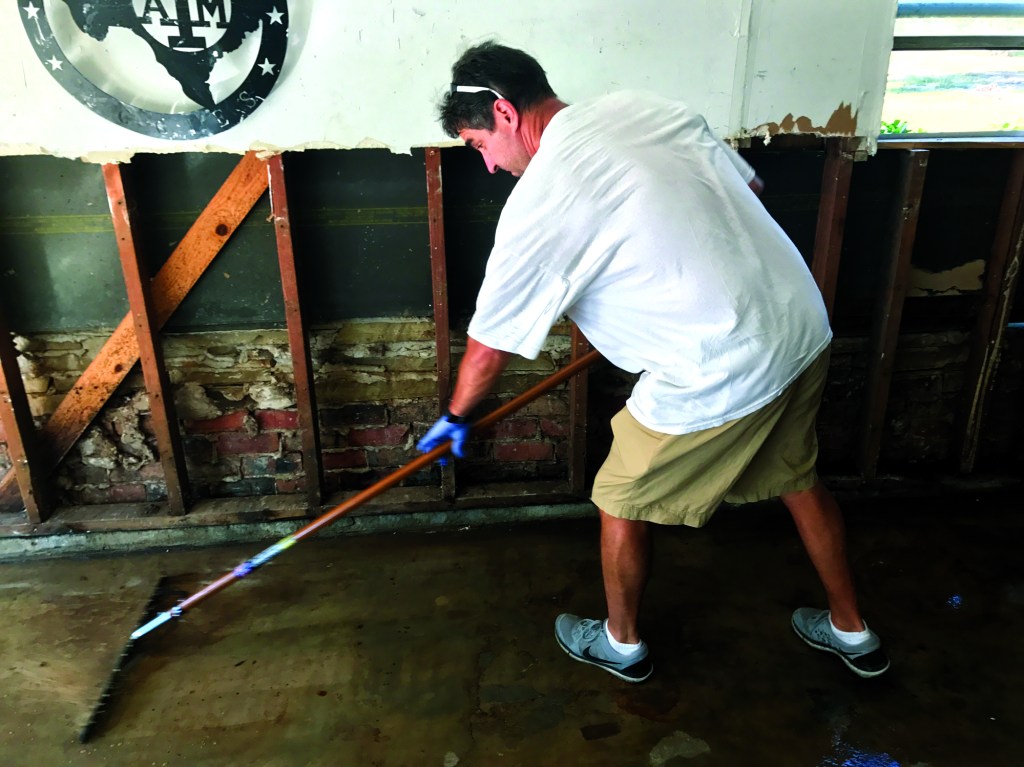When Hurricane Harvey dumped a record-shattering 50-plus inches of rain on Houston at the end of August, many homes in the low-lying Houston neighborhood of Meyerland were flooded for the third time in just three years.
Homeowners in Meyerland are experienced hands now, and they know the drill: Rip out the drywall, rip out the insulation, rip out the wood floors or the carpet, dump it all at the curb with your ruined furniture, your clothes, and your other belongings, and get ready to file another flood insurance claim.
A few homeowners in Meyerland, however, were fortunate enough to escape flood number three. Meyerland resident Drew Shefman is one: As Harvey approached, Shefman and his family made the news by managing to get their home lifted up 4 feet and set on cribbing barely a week before the storm arrived. Floodwaters fell short of flooding the Shefman home by a scant 6 inches; since then, contractor Arkitektura has come back to lift the house another 6 feet. Today, the house sits 10 feet above grade.
But even elevating a house turned out not to be a fail-safe strategy in Meyerland. According to the Houston Chronicle, a nearby home belonging to Jeffrey Tarrand had been elevated 42 inches after tropical storm Allison flooded the area in 2001. Harvey displaced Allison in the record books; Harvey also submerged Jeffrey Tarrand’s elevated first floor under 22 inches of water.
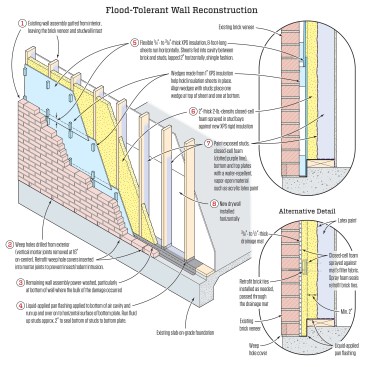
Tim Healey
In the aftermath of Hurricane Harvey, building scientist Joe Lstiburek has proposed the method shown here for remediating flood-damaged houses in the Houston market, where brick veneer exteriors and slab foundations are common. In theory, the details should reduce water damage and make cleanup and repair easier the next time the building is hit by a flood. The centermost insulation layer is watertight and impermeable, while materials toward the inside and outside faces of the wall allow drying by diffusion.
ASSESSING THE RISK
Harvey was an epic storm. It wandered aimlessly around the Texas coast for days after landfall, dropping 40 to 60 inches of rain. And while Harvey flooded many homes that had been flooded repeatedly in the past, it also flooded homes that had never experienced flooding before. An estimated 80% of the flooded area fell outside the boundaries of the government’s official flood plain. Harvey’s story highlights one of the uncomfortable realities about flood: It’s unpredictable.
Based on rainfall alone, Harvey qualifies as a “500-year flood”—meaning that in theory, a similar event would be expected to happen at that location once every 500 years, on average. The official flood-plain maps of the Federal Emergency Management Agency (FEMA) are based on a higher likelihood: a 1% chance of flooding in any given year (the so-called “100-year flood”). But neither term really means what it sounds like it means. Hundred-year floods happen every year, somewhere in the country. And even 500-year floods aren’t necessarily all that rare. “By some calculations,” researchers Nicholas Pinter, Nicholas Santos, and Rui Hui, of the Center for Watershed Sciences at the University of California-Davis, wrote after Hurricane Harvey, “the current flooding represents the third ‘500-year’ flood in the Houston area in the past three years.”
When severe flooding hit Nashville, Tenn., in May 2010, the event was described as a “1,000-year flood.” And in 2016, rains that brought devastating floods to Baton Rouge, La., and vicinity also got the “1,000-year” label from the National Weather Service office in Slidell, La.
Climate scientists predict an increasing incidence of heavy rainfall and serious flooding as the earth’s atmosphere continues to warm in coming decades. But climate change or no climate change, the sad truth is this: We know it’s going to flood. What we don’t know is exactly where, exactly when, or exactly how deep.
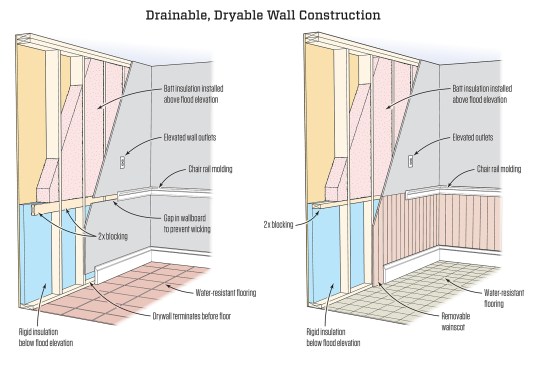
Tim Healey
The drawing above illustrates the “wash-and-wear wall” concept for flood repair on existing homes advocated by Professor Claudette Reichel, director of the Lousiana State University (LSU) Ag Center’s “LaHouse” project, and included by FEMA as a suggestion in the agency’s advice for repairing flooded homes. Upper portions of the wall are left as is, while lower portions receive flood-tolerant materials. If flood recurs, lower portions of the wall will be easier to clean, dry, and put back into service.
THE INSURANCE PROBLEM
The unpredictable nature of flooding is a major challenge for the federally-backed National Flood Insurance Program (NFIP), which is run by FEMA. The agency is midway through a complex and technically difficult reworking of the NFIP’s Flood Insurance Rate Maps, or FIRMs, which define the official boundaries of the “flood hazard zone”—the locations where NFIP flood insurance is required for homes carrying federally-backed mortgages. Huge parts of the country still have outdated flood-zone maps that date back to the 1980s and earlier. And even the agency’s state-of-the-art new maps, where they have come into force, represent only a best guess, despite the application of advanced ground elevation measurement technology and sophisticated computer modeling.
And no matter how advanced the mapping technology, no map can ever be perfect—because as Claudette Reichel, a professor at the Louisiana State University Agricultural Extension, points out, the flood plain itself is a moving target: Flood risks change from year to year in response to natural and man-made changes in rainfall and flow patterns. When record-setting rainfall soaked Reichel’s own region in the summer of 2016, 80% or better of the flooded properties were outside the official flood plain—just like in Houston in the summer of 2017. And just like in Houston, most of the flooded property owners in Louisiana didn’t have any flood insurance.
PRACTICAL PREPAREDNESS
Ideally, says Claudette Reichel, homes in places where flood is a serious risk should be built above the anticipated flood level. But even for new construction, that’s an expensive proposition. For an existing house, dollars can be a deal-breaker. The cost of raising an existing home to get it above the flood line is prohibitive for most people, especially if the house is built on a slab foundation.
But if the money’s not there to raise the house, Reichel says, homeowners still have choices. After Hurricane Katrina flooded New Orleans in 2005, building scientist Joe Lstiburek developed a set of recommended details for rebuilding walls in flood-damaged wood-frame houses that can’t be readily elevated (see the illustration “Drainable, Dryable Wall Repair,” below), as well as suggestions for flood-tolerant masonry cavity-wall and mass-wall construction (see illustrations, below).
Lstiburek’s post-Katrina rebuilding recommendations focused on typical southern Louisiana construction methods, with modifications intended to make the buildings more tolerant of standing water and easier to open up, clean, dry, and put back into service after a flood. Reichel, who describes the idea as “drainable, dryable, flood-hardy restoration,” popularized the details on the LSU Ag Center’s website, and continues to educate Louisiana property owners on the concept. And after JLC’s Coastal Contractor magazine published a drawing of Lstiburek’s suggestion for wood-frame walls in 2006, the illustration found its way into FEMA guidance for homeowners repairing their properties after a flood.
Following Hurricane Harvey, Lstiburek has evolved similar guidance tailored to the construction style that’s typical of the Houston market, where many homes are built on slabs and clad with brick (see the illustration “Flood-Tolerant Wall Reconstruction,” above). In this go-round, Lstiburek is moving away from the idea of saving any interior wall covering. Floodwater tends to be “filthy,” Lstiburek observes, and interior wallboard is likely to be ruined every time the property floods—and probably has to come off in any case to allow thorough cleaning and disinfecting of the wall cavity.
In this latest incarnation of flood hardy, Lstiburek is assuming that the home’s sheathing will also have to come out, leaving the exterior brick cladding exposed from the back. All of the framing as well as the brick has to be washed, scrubbed, rinsed, and disinfected, he says, with particular attention to the base of the wall where dirt and sediment may have collected. Then it has to be dried.
When the wall is ready to be reconstructed, Lstiburek suggests two possible ways to establish an air barrier and drainage plane on the interior side of the brick cladding. One way would be to slide rigid closed-cell extruded polystyrene (XPS) insulation into the cavity between the brick and the studs, jamming the insulation into place with small pieces of XPS to hold it temporarily, and then applying closed-cell spray foam against the XPS and between the studs. This would create an effective air barrier and also achieve some lateral stiffening of the wall structure.
Lstiburek’s other suggestion is to place a fabric-faced open-weave drainage plane material such as Benjamin Obdyke Home Slicker against the brick, then apply the spray foam against the fabric for insulation and air-sealing.
Either method would create a drainage and drying gap behind the brick, outboard of the insulated wall. But first, says Lstiburek, the base of the wall should be coated with fluid-applied flashing to make a drain pan at the bottom of the wall. And weep holes should be cut at vertical joints in the bottom course of brick to allow water to exit the cavity.
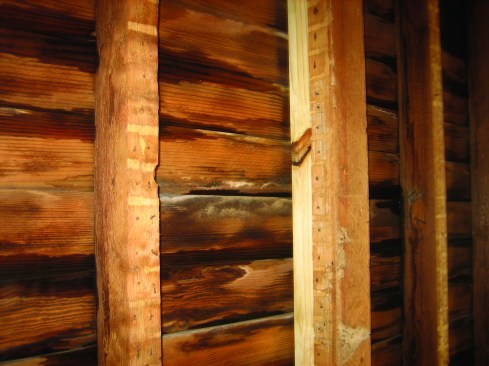
In historic New Orleans, there are many buildings where the old board siding cannot be removed.
SAVING HISTORY
Louisiana building-science consultant Paul LaGrange has been working with the LSU Ag Center since the days of Katrina, helping to design and develop the center’s LaHouse high-performance home demonstration project. After Katrina, LaGrange found himself working on flood restoration of old balloon-framed New Orleans buildings. Many of the structures were uninsulated, with board siding applied directly to the wood studs.
“Some of these were listed as historic properties, and some weren’t,” says LaGrange. “But either way, in many cases we weren’t able to remove the existing board siding. But we still had to improve the air barrier, the drainage plane, and the thermal barrier. And the way you do that with a historic house is very different from the way you would with a modern-construction home that was platform framed with structural panel or gypsum-board sheathing and interior drywall.”
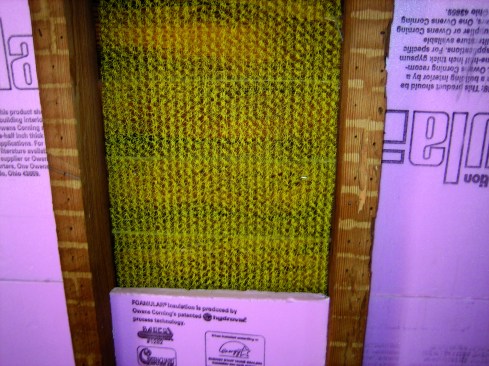
Consultant Paul LaGrange opted to place open-weave drain fabric against the wall, set rigid polystyrene insulation board against the drainage material.
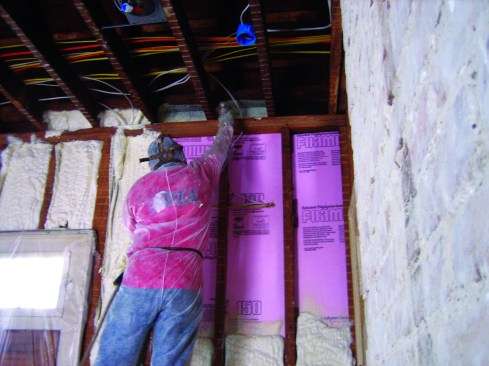
He sealed the cavities with closed-cell highdensity spray foam insulation.
For those older buildings, LaGrange had to work from the interior. The methods he came up with (see photos, above) resemble Joe Lstiburek’s recommendations for brick-clad Houston homes: LaGrange placed Home Slicker against the board siding, cut and fit sheets of XPS to hold the drainage fabric in place, and applied closed-cell spray polyurethane to air-seal the wall and lock the components together.
Like Lstiburek’s recommendations for Houston, and like the drainable, dryable wall shown above, LaGrange’s solution for balloon-framed houses should make the houses easier to fix in the event that they flood again. But so far, none of the buildings LaGrange worked on have been flooded a second time.
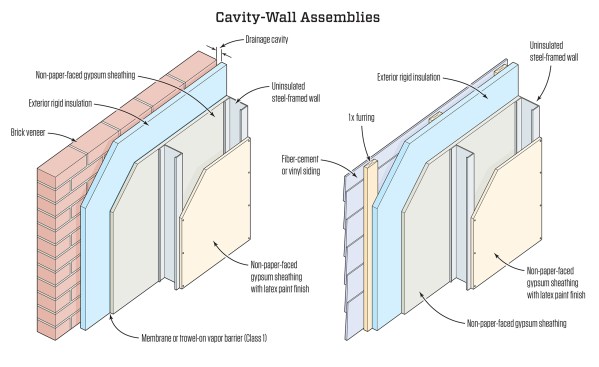
Tim Healey
Above is a rendering of two drainable and dryable cavity-wall assemblies proposed by building-science expert Joe Lstiburek after Hurricane Katrina. The wall designs share several key characteristics: No water-sensitive materials are used in the construction; exterior cavities are drainable and vented to the exterior; and interior cavities can be opened to allow passive or fan-forced drying in the event of a flood, by removing strips of wall material at top and bottom. Lstiburek cautions, however, that floodwaters are usually “filthy,” requiring the interior side of the wall to be opened up, scrubbed, rinsed, and disinfected.
“WASH-AND-WEAR” RECONSTRUCTION
In any flood, the extent of the damage, and the demolition required, will vary depending on how deep the floodwater is, how dirty it is, and how long it sits in the house. In some cases, the interior wallboard may have to be completely stripped out. In others, just the lower wall may need gutting. In a best-case scenario, homeowners might be able to just remove strips of material and flush out the walls. But in any case, says Claudette Reichel, applying flood-hardy methods like the details shown above could save homeowners from months of displacement from their houses.
And unlike elevating the house, “wet floodproofing” (the FEMA term for the technique) isn’t an all-or-nothing proposition. Homeowners can apply as much of the approach as they have time or resources for. Says Reichel: “Anything you do reduces your damage next time. You could elevate your water heater and your air conditioner compressor, but maybe not your refrigerator. Or for example, a lot of people in our area went back with floorings that were more resilient—interlocking vinyl flooring was flying off the shelves at the home center—but they didn’t necessarily do the drainable dryable wall part.”
But any measures taken this time around will pay off in the next flood, says Reichel. “The more wet floodproofing techniques they use, the less the ordeal. They would not be homeless for a year. They would not be competing with everyone else for new materials. All they have to do is clean and dehumidify to speed-dry, and they’re back in.”
“If they don’t elevate their outlets and their switches, and those get underwater, those need to be replaced,” cautions Reichel. “But at least the home is still livable. And if it’s fresh water, not salt water, you don’t have to replace the wiring—just the receptacles.”
CLEANING AND GUTTING
As JLC goes to press this month, Houston is not ready for reconstruction. Thousands of volunteers have flocked to Houston to help, but for now, the job is demolition. “They are focusing on gutting and drying,” says Paul LaGrange, “and they are actually drying it right. They are taking that four to eight weeks, depending on how long the water sat, and what products got wet, to dry those facilities. And of course they are sanitizing to prevent organic growth.”
In the 2016 Louisiana flood, LaGrange says, some homeowners were in too big a hurry. “They were not drying their homes thoroughly enough, to a 15% moisture content or less, before they started re-insulating and hanging drywall.” One common mistake is to measure moisture content at the surface of the wood, says LaGrange: “They weren’t inserting the pins of the moisture meter into the center of the wood framing to gather accurate measurements. So you still had moisture that was emerging from the center of that wood, and people were hanging drywall way before their homes were completely dry.”
Builder and JLC author Matt Risinger, who is based in Austin, Texas, has traveled to the Houston area with volunteers from his church to help gut several homes. At first, says Risinger, it was discouraging. “One of the houses I went to, the water was just absolutely disgusting,” he says. “The open-cell insulation was like a sponge. You could push on it and water would spurt out on you.”
“But by the end of the day,” says Risinger, “once we ripped out all the drywall and the foam, I felt like, ‘Okay, this house is salvageable. We’re back to a situation as if it was in framing and had gotten wet.’ And you know, houses get wet in framing all the time. We can deal with that, if it’s dryable.”

Tim Healey
Masonry mass-wall assemblies proposed by Joe Lstiburek after Hurricane Katrina are reminiscent of traditional wall structures seen in historic buildings in New Orleans, some of which survived historic floods. Unlike the historic techniques, however, these insulated walls are adapted to modern space-conditioning and energy-efficiency expectations. The materials are chosen to be tolerant of water, and the least moisture-permeable material (the extruded polystyrene insulation board) is located at the center of the wall profile, so that moisture can diffuse out of the walls in two directions from the center.
THE LIVING LABORATORY
Joe Lstiburek’s, Claudette Reichel’s, and Paul LaGrange’s advice is based on sound building-science principles and backed by a wealth of experience. But so far, the advice is mostly theoretical. A few houses in Louisiana have been given the flood-hardy treatment, but most have not. In the 2016 floods, says Paul LaGrange, “the vast majority of these folks did not have flood insurance because they were not in the flood plain. They were looking to get back their homes as quickly and inexpensively as possible.” Many who couldn’t afford even basic repairs sold out at a loss, and their homes were converted into rental housing.
But neighborhoods like Houston’s Meyerland may serve as a proving ground. After his first flood, Drew Shefman says, he just wanted to get back into his house; his remodel included carpeting, which was ruined six weeks later when the second flood hit.
After the second flood, Shefman says, he started to think; on some exterior walls, he used plywood paneling attached with screws instead of using drywall, and he replaced his ruined carpet with vinyl flooring. But those ideas were not tested by the third flood, because Shefman lifted his house in the nick of time.
The rest of Meyerland has some decisions to make. “Two of my neighbors are selling,” says Shefman. “One is going to rebuild. One is going to lift. A couple are still trying to figure out what they’re going to do.” Whatever they decide, those homeowners, their community, and the broader building and remodeling community will get the chance to learn something from their choices—because as uncertain as weather can be, one prediction seems reasonable: Houston is absolutely certain to see floodwater again.
